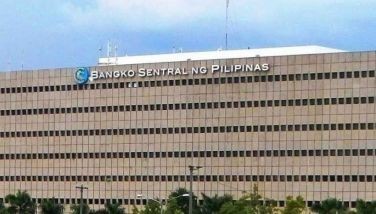ADB sees strong growth for developing Asia through ’07
April 7, 2005 | 12:00am
The Asian Development Bank (ADB) expects Asia, again led by China, to grow 6.5 percent this year and 6.6 percent in 2006 despite high oil prices, moderating global growth and the risk of a sharp dollar depreciation.
In its annual outlook for Asia excluding Japan, the ADB said yesterday that buoyant domestic demand and stronger trade ties would carry over from 2004, when the 7.3 percent growth was the region’s most robust since the Asian financial crisis of 1997-98.
China, with its voracious appetite for Asia’s exports, will see growth ease to 8.5 percent this year from 9.5 percent in 2004, the Manila-based bank said, adding more austere tightening may be needed to curb over investment and achieve a soft landing.
While most of Asia had become more resilent to economic shocks since the Asian crisis, the ADB said said much depended on developments in major industrialized countries and China.
"The problem of external imbalances in the US could become worse, triggering a sharp depreciation of the dollar, a spike in inflation and more sudden increases in interest rates, thus ultimately restraining world growth and trade," it said.
Other risks for Asia included an overheating in the Chinese economy, epidemics, terrorism, diverging foreign exchange rates, currency speculation and sustained high oil prices.
The price of Brent crude was seen averaging $41 a barrel in 2005, the ADB said, with demand from China and other major Asian importers – Hong Kong, India, South Korea, Singapore, Thailand and the Philippines – likely to help keep it at $39 in 2006.
Brent crude traded above $56 a barrel on Tuesday.
South Korea’s consumption slump seemed to be ending, it said, but expansionary policies and better balance sheets would take time to lift growth, forecast at 4.1 percent this year.
Southeast Asia’s 5.4-percent expansion in 2005 will be backed by consumption and investment, but the ADB said its forecast "depends critically" on inflation staying moderate.
India should grow 6.9 percent this year after 6.5 percent in 2004 but faced the challenges of meeting fiscal consolidation targets, stepping up infrastructure investment, managing growing foreign exchange reserves and reinforcing its textiles industry.
The ADB urged Asia to pursue some coordination of exchange rate movements, saying recent divergence against the dollar may lead to greater volatility of regional currencies against each other at a time when the economies were growing more integrated.
"Asia has been an intrinsic part of the global imbalances, by producing large current account surpluses and financing a significant share of the US twin deficits mainly through large purchase of US securities," the ADB said.
"As Asia is increasingly expected to share the burden in the adjustment process, Asian currencies may experienc proportionately larger appreciation."
After Asia enjoyed $69.3 billion in net foreign direct investment in 2004, it will remain a preferred destination – even as global growth slowed – provided countries can keep or bolster their competitive advantages.
In this context, furtherance of economic, governance and administrative reforms, as well as improvements to infrastructure, will be particularly important," the ADB said.
In its annual outlook for Asia excluding Japan, the ADB said yesterday that buoyant domestic demand and stronger trade ties would carry over from 2004, when the 7.3 percent growth was the region’s most robust since the Asian financial crisis of 1997-98.
China, with its voracious appetite for Asia’s exports, will see growth ease to 8.5 percent this year from 9.5 percent in 2004, the Manila-based bank said, adding more austere tightening may be needed to curb over investment and achieve a soft landing.
While most of Asia had become more resilent to economic shocks since the Asian crisis, the ADB said said much depended on developments in major industrialized countries and China.
"The problem of external imbalances in the US could become worse, triggering a sharp depreciation of the dollar, a spike in inflation and more sudden increases in interest rates, thus ultimately restraining world growth and trade," it said.
Other risks for Asia included an overheating in the Chinese economy, epidemics, terrorism, diverging foreign exchange rates, currency speculation and sustained high oil prices.
The price of Brent crude was seen averaging $41 a barrel in 2005, the ADB said, with demand from China and other major Asian importers – Hong Kong, India, South Korea, Singapore, Thailand and the Philippines – likely to help keep it at $39 in 2006.
Brent crude traded above $56 a barrel on Tuesday.
South Korea’s consumption slump seemed to be ending, it said, but expansionary policies and better balance sheets would take time to lift growth, forecast at 4.1 percent this year.
Southeast Asia’s 5.4-percent expansion in 2005 will be backed by consumption and investment, but the ADB said its forecast "depends critically" on inflation staying moderate.
India should grow 6.9 percent this year after 6.5 percent in 2004 but faced the challenges of meeting fiscal consolidation targets, stepping up infrastructure investment, managing growing foreign exchange reserves and reinforcing its textiles industry.
The ADB urged Asia to pursue some coordination of exchange rate movements, saying recent divergence against the dollar may lead to greater volatility of regional currencies against each other at a time when the economies were growing more integrated.
"Asia has been an intrinsic part of the global imbalances, by producing large current account surpluses and financing a significant share of the US twin deficits mainly through large purchase of US securities," the ADB said.
"As Asia is increasingly expected to share the burden in the adjustment process, Asian currencies may experienc proportionately larger appreciation."
After Asia enjoyed $69.3 billion in net foreign direct investment in 2004, it will remain a preferred destination – even as global growth slowed – provided countries can keep or bolster their competitive advantages.
In this context, furtherance of economic, governance and administrative reforms, as well as improvements to infrastructure, will be particularly important," the ADB said.
BrandSpace Articles
<
>
- Latest
- Trending
Trending
Latest
Trending
Latest
Recommended




























